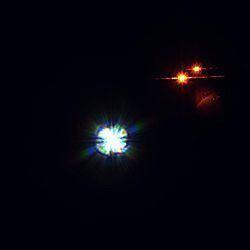Magnitude 7.11 Apparent magnitude (V) 7.11 | ||
 | ||
Similar HR 4796, HD 100546, Beta Pictoris, Gliese 570, MWC 480 | ||
HD 141569 is a blue-white dwarf star approximately 320 light-years away in the constellation of Libra. The primary star has two red dwarf companions (orbiting each other) at about nine arcseconds. In 1999, a protoplanetary disk was discovered around the star. A gap in the disk speculate a possible extrasolar planet forming in the disk.
Contents
Protoplanetary disk
In January 1999, NASA announced a protoplanetary disk around HD 141569. The Hubble Space Telescope showed that the disk appears to come in two parts (inner and outer). It superficially resembles the largest gap in Saturn's rings (known as the Cassini division).
The vast disk is 75 billion miles across (13 times the diameter of Neptune's orbit). The inner edge of the gap is 21 billion miles from the star. The relatively narrow gap lies approximately halfway between the inner and outer edges of the disk. Though already a fully formed star, HD 141569 is relatively young, probably only 1% through its lifetime as a stable star. The star is nearly three times more massive and 22 times brighter than the Sun.
HD 141569 was first identified as a source that might have a disk in 1986 as a result of observations done with the Infrared Astronomical Satellite (IRAS). Thermal radiation emitted by the warmed dust was observed in images taken in June 2016 at the W. M. Keck Observatory.
Light from the central star which was reflected from dust particles in the disk was captured by Hubble's Near Infrared Camera and Multi-Object Spectrometer (NICMOS) at a wavelength of 1.1 micrometres. At the distance of HD 141569, the crisp resolution of the telescope and camera combination reveals structures as small as 1 billion miles across. Dust disks surrounding newly forming stars are common, but only a small number of adult stars are known to have disks; of these, only a handful have been imaged. Astronomers believe these disks must form and/or be replenished when older rocks and debris collide and break up into small particles.
Possible planet
The gap in the disk leads to the conclusion of a protoplanet in formation around the star. The planet does not have to be in the gap, however. It could either be sweeping up the dust and rocks from the disk as it travels in its orbit around the star, or the gravity of the planet could knock the dust out of one part of the disk.
